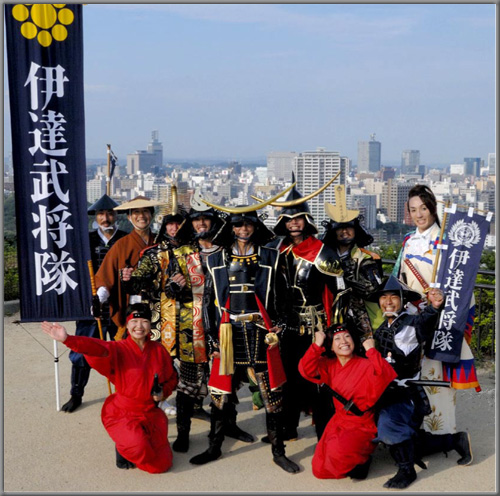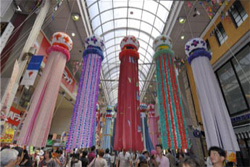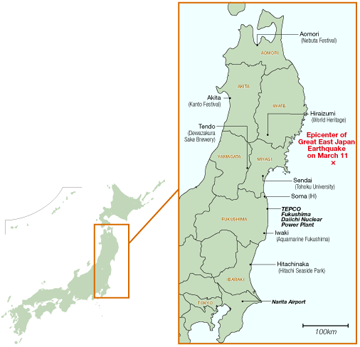Home > Highlighting JAPAN > Highlighting Japan SEPTEMBER 2011 > A Rousing Summer in Tohoku
Highlighting JAPAN
COVER STORY: A Rousing Summer in Tohoku
Caption: Members of the Date Bushoutai group at Sendai Castle.
The armor of Date Masamune (center) weighs over 20 kg.
Credit: YOSHIFUSA HASHIZUME
A Rousing Summer in Tohoku

Fukinagashi hang from the roof of a Sendai shopping arcade. Sendai Tanabata Festival is famous for its 4-m long fukinagashi, which have a kusudama (decorative ball) at the top and long thin strips of Japanese paper or cranes hanging down from them.
Credit: YOSHIFUSA HASHIZUME
What lent even more charge and splendor to the festival this year was the East Japan Bushoutai Summit held at Sendai Castle on August 7 and 8. Almost twenty bushoutai groups dressed up as warlords connected with the area have now been formed in Japan to promote tourism in the region. Gathering at the summit this time were a total of five teams based in Eastern Japan, including Miyagi, Yamagata, Saitama and Niigata Prefectures.

Since May after the Great East Japan Earthquake, the Date Bushoutai has given performances in major cities nationwide, in gratitude for the reconstruction assistance given to the Tohoku region and to promote the Tohoku region as it bravely works to get back on its feet.
"When the disaster struck, we received encouragement and support from around the world. We are truly grateful. The Date Bushoutai send the vitality of Tohoku as a signal to the world!" When the young man dressed up as Date Masamune raised the war cry, the 1,000-strong audience packed into Sendai Castle burst into applause, then fixed their eyes on the display of martial arts by the Date Bushoutai and four other bushoutai.
Besides the Sendai Tanabata Festival, other traditional festivals were held as usual this summer in various parts of the Tohoku region. Also, many tourist spots, including Hiraizumi, which was listed as a World Heritage site in June, were bustling, and all types of industry have recovered to their pre-earthquake levels. This month's feature article presents the face of Tohoku as it begins the steady march toward recovery, six months after the Great East Japan Earthquake.
© 2009 Cabinet Office, Government of Japan






